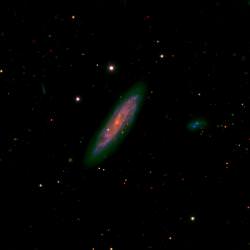First light is a big deal. That’s when a new observatory opens up for the first time and gathers light on its detectors. It’s even a bigger deal when the world’s most powerful telescope sees the night sky for the first time. Astronomers get ready for the Large Binocular Telescope.
I’ve been writing stories about the LBT for years now, so it seems a little surreal to be reporting on its first light. But here we are. So, for those of you who haven’t been obsessing about this monster since it was first conceived, here’s the breakdown.
The Large Binocular Telescope, in case you hadn’t guessed, is actually two 8.4-metre telescopes perched side-by-side. Although they’re separate, they work together to act like a single, much larger telescope. They have the light-collecting power of an 11.8-metre telescope, and their combined light produces an image sharpness of a single 22.8-metre scope.
The first light images for the LBT were captured in January, and show the galaxy NGC 2770, located 102 million light-years away. The same scene was captured in ultraviolet and green light to show the regions of active star formation. And then it was captured again in red to show the older, cooler stars. Finally, a third composite image was put together that shows both features at the same time.
Now for a bit of history. The observatory’s structure was moved up to the top of Arizona’s Mount Graham in 2002. The first mirror was delivered in 2003, and aligned in 2004. The second mirror was delivered in 2005, and the first individual images where captured soon after that. But it wasn’t until this year that both halves were brought together to act as a single large observatory.
The first light is a great step. I can’t wait for the discoveries to pour in.
Original Source: University of Arizona News Release


Wow! That’s a quality first light image…
I Would be happy with 120 mm. binoculars! LOL!
Why the keck telescopes doesnt act in the same way?
I have personally followed the progress on the LBT for 5 years. Finally our patience will be rewarded! One functioning mirror is something , but now that both are working together, my enthusiasm has doubled ! Watch closely,folks, this is going to be spectacular !!
A bit strange to be talking of “first light for the LBT” when a bunch of science papers have already appeared on results derived with one mirror…
Note that there is a good reason for shooting NGC 2770: two supernovae at the same time!! It’s the two white stars on the galaxy, one lower left of center, the other in the top right tip. The latter was discovered right upon explosion due to an X-ray flare detected by Swift.
@Alonso Garcia: Keck can work as an interferometer, but LBT has both mirrors on one beam, which makes it much easier to switch them together.
AFAIK the overall size of the Keck observatory is bigger [2 telescopes 10m each]and the VLT (European South Observatory in cile ) is even bigger ( 4 telescopes of 8.4m ).
nice work! pretty good image. I’m looking forward to many more……………..
I HAVE TOURED THE VLT ESO IN CHILE ON PARDINAL (not sure of spelling) MTN. IT IS IN FACT 4 TELESCOPES INTERCONNECTED
Finally!!, in a very brief period of time we will actually be able to look directly at planets beyond our solar-system, rather than relying on techniques that just merely detect their presence.
I can’t imagine the astonishment when we discovery the first blue planet that is similar to Earth. 🙂
Because they are too far apart. The mirrors in the Binocular Telescope are mounted on the dsame frame right next to each other, the Keck scopes are 85 meters apart. They can be used together as an interferometer, but the set up is a lot more complicated and while it is great for some types of observations, they can’t be used in the same way as the Binocular Telescope to create sharper images.
I saw the LBT on TV. I was wondering if the images would be in 3rd dimension since if you look into a regular telescope it is in a 2 dimension image but when you look into a pair of binoculars would you not get a better dimension of space images since it is two lenses working simultaneously.
If anyone is still checkin this site…
zoom in the first telescope as much as you can, get it clear, put another telescope in front of it. the same way you can do that with 2 binoculars to get even closer to an object. it gets a little blurry and hard to find the second image but as scientists I bet you can clear up the images 🙂
ahh doo laa lali